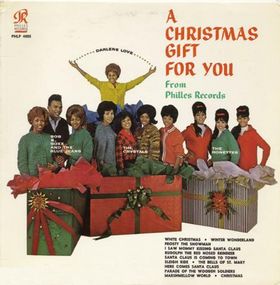
The sound of mid-20th-century Americana was perhaps best captured by composer Leroy Anderson, the son of two Swedish immigrants. Among his most notable “light-orchestra” works are The Syncopated Clock (1945), The Typewriter (1950), and Bugler’s Holiday (1954). However, his most famous composition is the energetic and playful Sleigh Ride, which he first began to sketch in the summer of 1946 at his wife’s family’s cottage in Woodbury, Connecticut. Yet again, a wintertime song was born out of the desire to escape unpleasantly high temperatures. Anderson would not finish the work until February 1948. Sleigh Ride was premiered by the Boston Pops Orchestra on May 4, 1948 with Arthur Fiedler conducting. Since then, it has been known as the BPO’s signature piece. They recorded it for RCA Victor the following year, and just like the holiday-neutral “Let it Snow! Let it Snow! Let it Snow!”, it immediately became a Christmastime standard. Anderson’s wife Eleanor recalled hearing it playing in department stores in New York City in December of 1949. She explained: “Leroy didn’t set out to write a Christmas piece when he wrote Sleigh Ride. His intentions were to convey the entire winter season through the imagery of a sleigh ride, much in the way that Mozart did with his piece of the same name.”¹ Chances are, if you’re one who seeks out commercial Christmas music, you’ve heard Anderson’s more deliberately holiday work, A Christmas Festival, a medley of traditional carols that he composed in October 1952.

The lyrics for Sleigh Ride weren’t written until 1950, and they were not by Anderson. Mitchell Parish, who added lyrics to several instrumental classics by Anderson and other composers, used the existing title and melody to pen a musical invitation, where the singer is welcoming the listener to come along on a ride through a wintry paradise. Parish sums up the scene he paints in the line “It will nearly be like a picture-print by Currier and Ives” (see a sample print above). Again, Parish’s original lyrics make no specific mention of Christmas, though some artists, such as The Carpenters and Air Supply have substituted “Christmas party” in the line “There’s a birthday party at the home of Farmer Gray.”
The first recording with Parish’s lyrics was released in 1950 as a single by the Andrews Sisters. In 1963, another female vocal trio, The Ronettes, recorded a Motown style version for A Christmas Gift for You from Philles Records (see left; later released as A Christmas Gift for You from Phil Spector) that replaces Anderson’s imitated horse whinny on trumpet with an authentic one and includes no fewer than five key changes! Speaking of excessive modulations, Andy Williams’ version from Merry Christmas (Columbia, 1965) includes snappy back-up vocals and brass fills a la Burt Bacharach. That same year, the instrumental rock group The Ventures included a cover on their Christmas Album (Capitol Records, 1965).

There are some other fun re-imaginings of Sleigh Ride available online. Here is a jazzy piano arrangement by John Eidsvoog in 7/8 meter (think 1-2, 1-2, 1-2-3)! Ella Fitzgerald’s snazzy rendition from her album Ella Wishes You a Swinging Christmas (Verve, 1960) sets the perfect mood for a yuletide cocktail party. For me, nothing beats Leroy’s original orchestration–and the masses seem to agree! From 2009-2012 and then again in 2015, ASCAP² reported that Sleigh Ride was the most popular piece of Christmas music, with the 1950 Decca recording with Anderson conducting “His Pops Concert Orchestra” being the most frequently played in 2010. That’s scientific data validating that this enchanting piece has earned its spot in the American Christmas songbook.
¹Quote from the Leroy Anderson Foundation website. Mrs. Anderson was most likely referring to Wolfgang Amadeus Mozart’s “Die Schlittenfahrt” (No.3 in C, Trio from Three German Dances, K. 605), but she could have also been thinking of Die musikalische Schlittenfahrt, formally Divertimento in F Major, by Wolfgang’s father, Leopold.
²The American Society of Composers, Authors and Publishers–the agency that monitors public performance of copyrighted music. Leroy Anderson Foundation.
